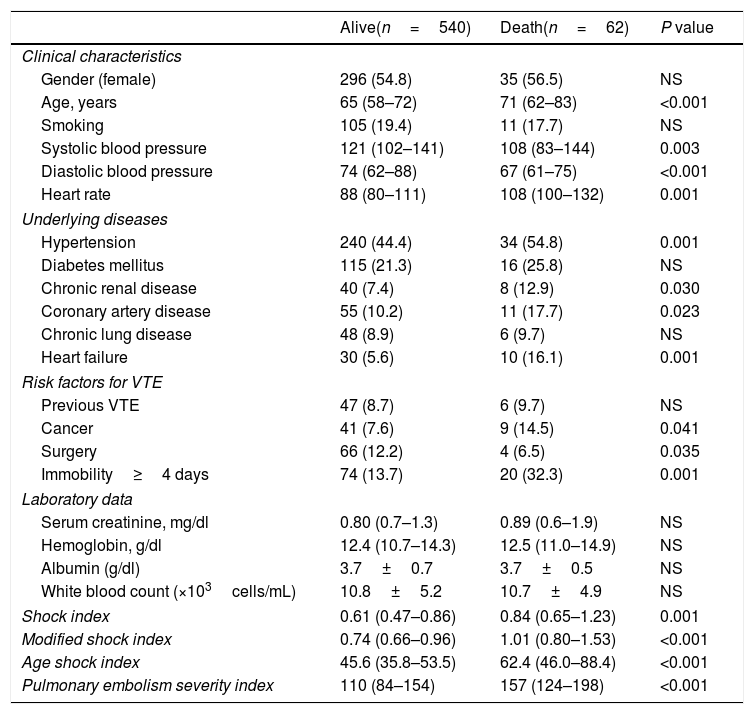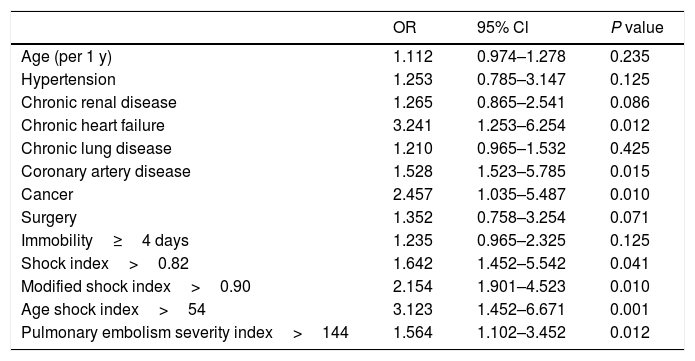The shock index (SI), modified shock index (MSI), and age shock index (ASI) have been reported to predict adverse outcomes in patients with different acute cardiovascular conditions. This study aimed to investigate the association between these indexes and in-hospital mortality in patients with acute pulmonary embolism.
MethodsThe medical records of all adult patients who were hospitalized with acute pulmonary embolism between June 2014 and June 2019, were examined. Collected data included vital signs, demographic characteristics, comorbidities, and laboratory values on presentation. The predictive value of SI, MSI, ASI, and pulmonary embolism severity index (PESI) for predicting in-hospital mortality were compared by C-statistics.
ResultsA total of 602 consecutive patients (mean age 66.7±13.2 years, 55% female) were included, and 62 (10.3%) of the patients died during their in-hospital course. The admission SI, MSI, ASI, and PESI were significantly higher in the deceased patients. After adjusting for other factors, the SI, MSI, PESI, and ASI were independent predictors of in-hospital mortality. The prognostic performance of ASI (C-statistics 0.74) was better than MSI (C-statistics 0.71), SI (C-statistics 0.68), and PESI (C-statistics 0.65).
ConclusionThe ASI may be used to identify patients at risk for in-hospital mortality following acute pulmonary embolism.
Se ha reportado la predicción de resultados adversos por parte del índice de shock (SI), índice de shock modificado (MSI) e índice de shock por edad (ASI) en los pacientes con situaciones cardiovasculares agudas diferentes. El objetivo del presente estudio fue investigar la asociación entre dichos índices y la mortalidad intrahospitalaria en los pacientes con embolia pulmonar aguda.
MétodosSe examinaron los registros médicos de todos los pacientes adultos hospitalizados por embolia pulmonar aguda entre junio de 2014 y junio de 2019. Los datos recabados incluyeron signos vitales, características demográficas, comorbilidades y valores de laboratorio al ingreso. Se comparó mediante el estadísticoC el valor predictivo de SI, MSI, ASI y el índice de severidad de la embolia pulmonar (PESI) para predecir la mortalidad intrahospitalaria.
ResultadosSe incluyó un total de 602 pacientes consecutivos (edad media 66,7±13,2 años, 55% mujeres), de los cuales 62 (10,3%) fallecieron en el curso de su estancia hospitalaria. La puntuación SI, MSI, ASI y PESI al ingreso fue significativamente más alta en los pacientes fallecidos. Tras ajustar el resto de factores, SI, MSI, PESI y ASI fueron factores predictivos independientes de la mortalidad intrahospitalaria. El desempeño pronóstico de ASI (estadísticoC 0,74) fue mejor que MSI (estadísticoC 0,71), SI (estadísticoC 0,68) y PESI (estadísticoC 0,65).
ConclusiónASI puede utilizarse para identificar a los pacientes en riesgo de mortalidad intrahospitalaria tras la embolia pulmonar aguda.










